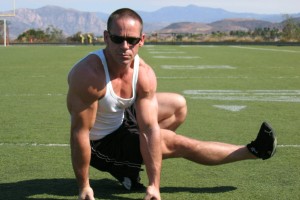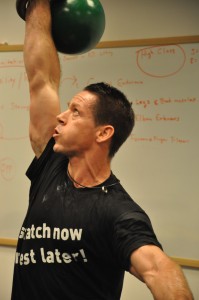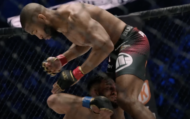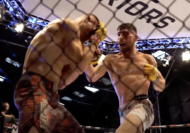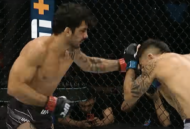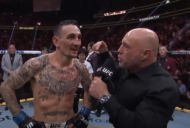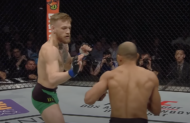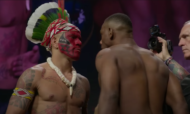Kettlebell Master Steve Cotter: “Kettlebell training always leaves (MMA fighters) completely smoked beyond anything they are used to”
By Cameron Conaway
There are three names that standout when it comes to kettlebell training: Pavel Tsatsouline, Mike Mahler and Steve Cotter.
From the age of 12, Cotter has been a martial artist. He was a US National Champion Full Contact Kuoshu fighter in 1995 and 1996, then went on to get his degree in Kinesiology at San Diego State University. He is now director and founder of the IKFF (International Kettlebell & Fitness Federation) which has certified instructors in every continent. If there is one who man who knows how kettlebell training can translate into MMA performance, it is Cotter.
FCF: Steve, there are many training devices and routines that come and go, especially within MMA circles where fighters are always on the lookout to gain an edge over their opponents. But the kettlebell has proven its longevity over time. Can you tell us how you got interested in kettlebell training, and what has maintained your interest over the years?
SC: I first became interested in kettlebells about nine years ago. I was just finishing my degree in Kinesiology and I had been carrying a very full load for almost four years. Prior to college, I had been training in martial arts full time – as in 8-10 hours per day, six days per week. Also, I had been training for and fighting full contact kuoshu, so I had developed for years the habit of training very vigorously and continuously.
I went from high intensity, high-volume, high-frequency training to carrying a back pack around and very little training. My body was changing for the worse and I did not like it.
I was about 32 years old at this time and I started really missing the elite level of physical conditioning that I had previously taken for granted. But I did not have the time to train at that level anymore and I was out of the habit. The commercial gym was not a good fit for me because of the social environment. So I was giving a lot of thought about what I could do to “get back” to a high level of fitness again.
I knew that I had to get smarter, to be able to accomplish more work in much less time. It was during this period of introspection and searching that I first saw the early advertisements for kettlebells. They intrigued me and I liked how the ad spoke about kettlebell being full-body training and utilized by martial artists and military personnel. So, I got a few KBs and a basic video and learned the movements that way initially.
Because of my extensive martial arts training, I was able to pick up the movements very quickly and my mind and body just took to the dynamic, ballistic nature of the lifts. There is a real art and science to kettlebell lifting. There are different stages of development, very much like those in the martial arts. In the beginning, most people come to kettlebell training for basic, or general fitness, and almost anything they do with a kettlebell will show improved results because it is new and different and, in most cases, superior to the traditional type of bodybuilding-influenced training protocols that most are familiar with.
For this basic or introductory level, something like RKC (Russian Kettlebell Challenge) is very suitable and appealing. However, further on, if the person sticks with kettlebells and wants to specialize and achieve his or her full potential, they have to study more and begin to learn the subtleties and nuances of kettlebell lifting. For example, in the competitive sport of kettlebell lifting, called Girevoy Sport, the level of skill and fitness is much, much higher than what is needed for general fitness and an expert must develop a very high degree of body control and technical precision as well as advanced well-rounded athleticism. So there are different levels and stages of growth and development, as is the case with martial arts systems. This continual study and development is what has and continues to capture my interest as both a student and teacher of kettlebell applied science.
FCF: Do you recommend that MMA fighters replace their traditional weight training routines with kettlebell work?
SC: Not necessarily. However, it depends on the training cycle and what the inherent strengths and weaknesses of the fighter are. Kettlebells are one highly effective tool in the toolbox. It does certain things very well but, for other things, there are more effective tools.
For example, if we look at the different strength and conditioning attributes of a well-rounded fighter, he needs to develop strength, conditioning, power, coordination and balance, and agility. Kettlebell training develops all of these qualities to varying degrees.
If the fighter is very fast and flexible, but is not strong and can be easily tossed about in grappling, then the basic barbell power lifts would be prescribed – movements like deadlift and squatting and a heavy press.
On the other hand, a strong fighter who lacks fitness or general conditioning will need to include some GPP training (General Physical Preparedness), such as circuit training. Now, if by “traditional” you are referring to bodybuilding, then I say yes – absolutely replace that with kettlebells, because bodybuilding has the goal of aesthetics, not function. Bodybuilding tends to work individual muscle groups for shaping and this is not how a martial artist should train to move. Martial arts utilizes full body movement, integrated strength, so any supplementary strength and conditioning work should also utilize full body movement patterns.
If we are looking at a well-rounded athlete who has a solid base of strength and fitness and mobility, then the primary focus will be to increase overall work capacity, which simultaneously improves strength, endurance, power and mobility. This is the specialization of kettlebell lifting – to work these attributes all together with one tool and one system, if it is a well-designed program.
FCF: You started your lifetime journey with physical fitness at age 12 through the martial arts. What role do the martial arts now play in your life?
SC: Martial arts will always be my foundation, both in terms of my physical base and my philosophical outlook and approach to health, fitness and wellness. Now I focus more on kettlebell and conditioning. Developing balance in the physiology is present in everything I do, including kettlebells.
I use kettlebells as my art now primarily, and also include qigong training for health and stress reduction. I do not fight any longer, however, I have a high level of all around strength and conditioning, which makes me a very difficult person to deal with in any case, even though I am not as sharp with my punches and kicks as I once was.
FCF: Who are some MMA fighters you’ve worked with? What results were you able to see in their strength and conditioning levels based on incorporating kettlebell training into their regimens?
SC: I’ve worked with quite a few over the years, but only for short instances. I have taught kettlebells to Diego Sanchez, introduced them to Randy Couture’s gym in Las Vegas, Mario Sperry, Eduardo Telles, Andre Galvao and some other lesser known MMA athletes.
Kettlebell training always leaves these guys completely smoked beyond anything they are used to (doing) in their normal training. It works the grip, the legs and back, the shoulders and the cardiovascular system. This makes for a more highly conditioned fighter.
I have only worked with these men on limited occasions because I am not a personal trainer and most MMA athletes unfortunately cannot afford ongoing, high-level training. Most of my time is spent traveling and running seminars internationally.
FCF: Lastly, can you tell us more about your organizations – IKFF and FullKOntact Kettlebells and Full KOntact Fitness?
SC: My primary work is with the educational organization I founded in 2008 – the International Kettlebell and Fitness Federation, or IKFF. I created this to provide a bridge between high-level fitness and sport and to provide a comprehensive mind-body fitness system, but also to provide an extensive resource for fitness professionals who need cutting- edge education to get to and stay at the top of their fields as trainers, athletes, coaches and therapists. We run workshops and instructor certification courses all over the world, on every continent. I have a real passion for educating and take my role seriously, investing a lot of time and resources to continually upgrade my own training as an athlete as well as a teacher.
Cameron Conaway is a former MMA fighter turned award-winning poet.


